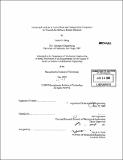| dc.contributor.advisor | Karl Iagnemma. | en_US |
| dc.contributor.author | Cheng, Nadia G. (Nadia Gen San) | en_US |
| dc.contributor.other | Massachusetts Institute of Technology. Dept. of Mechanical Engineering. | en_US |
| dc.date.accessioned | 2010-01-07T20:55:17Z | |
| dc.date.available | 2010-01-07T20:55:17Z | |
| dc.date.copyright | 2009 | en_US |
| dc.date.issued | 2009 | en_US |
| dc.identifier.uri | http://hdl.handle.net/1721.1/50574 | |
| dc.description | Thesis (S.M.)--Massachusetts Institute of Technology, Dept. of Mechanical Engineering, 2009. | en_US |
| dc.description | Includes bibliographical references (leaves 107-108). | en_US |
| dc.description.abstract | The purpose of this thesis is to investigate the use of a new class of materials for realizing soft robots. Specifically, meso-scale composites--composed of cellular solids impregnated with active fluids-were be designed to have controllable stiffness to take the form of a continuous body of a soft robot. This represents an improvement compared to past efforts in soft robotics, which often involved modifying the infrastructure of current, rigid robots to yield softer ones. This latter approach often faced the challenges of developing actuators that were "soft" but still discrete, and were limited in performance. In contrast, the controllable-stiffness composites proposed in this thesis eliminate the need for multiple actuators; a single structure can transition between various states to serve as both rigid, load-bearing components as well as morphable, compliant ones. While the vast range of fluid-foam combinations for such an application have yet to be explored, the work presented here focuses on a specific composite: open-cell polyurethane foam impregnated with wax. This type of composite can be thermally activated to exhibit both solid and nearly fluid states (while the wax can be melted to become a fluid, the foam holds the composite together as a pseudo-solid). This thesis discusses the research that has been conducted to 1) characterize the mechanical properties of wax-foam composites as well as 2) investigate possible ways in which the composites can be used as robotic components. | en_US |
| dc.description.statementofresponsibility | by Nadia G. Cheng. | en_US |
| dc.format.extent | 108 leaves | en_US |
| dc.language.iso | eng | en_US |
| dc.publisher | Massachusetts Institute of Technology | en_US |
| dc.rights | M.I.T. theses are protected by
copyright. They may be viewed from this source for any purpose, but
reproduction or distribution in any format is prohibited without written
permission. See provided URL for inquiries about permission. | en_US |
| dc.rights.uri | http://dspace.mit.edu/handle/1721.1/7582 | en_US |
| dc.subject | Mechanical Engineering. | en_US |
| dc.title | Design and analysis of active fluid-and-cellular solid composites for controllable stiffness robotic elements | en_US |
| dc.type | Thesis | en_US |
| dc.description.degree | S.M. | en_US |
| dc.contributor.department | Massachusetts Institute of Technology. Department of Mechanical Engineering | |
| dc.identifier.oclc | 464227981 | en_US |
